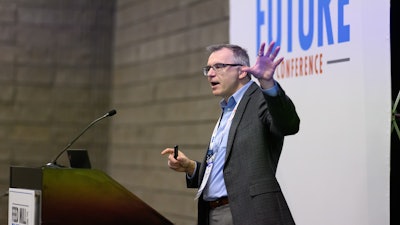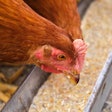
Relying on sustainability tools like Life Cycle Assessment (LCA) software and following guidelines from the Food and Agriculture Organization (FAO) of the United Nations can help feed manufacturers reduce their greenhouse gas (GHG) emissions and contribute to a more sustainable food supply chain.
Dr. Milan Hruby, vice president of creation design and development for ADM Animal Nutrition, highlighted how utilizing such resources has influenced ADM’s business strategies in his keynote address, Reducing supply chain emissions: Innovations in feed production and beyond, at the Feed Mill of the Future Conference on January 30 in Atlanta.
Driven by the need to provide nutritious protein to a projected population of 10 billion people by the year 2050, ADM developed its Strive 35 sustainability initiative, which outlines the reduction of Scope 1, 2 and 3 emissions 25% by 2035, the reduction of water withdrawal 10% by 2035 and the reduction of energy usage 25% by 2035.
Scope 1 refers to a company’s direct emissions from facilities and vehicles, Scope 2 are indirect emissions from purchased energy sources like wind, solar or the power grid, and Scope 3 are indirect emissions from purchased goods and services, distribution and downstream processing.
ADM’s Scope 3 emissions are their leading source of emissions and 80% of these emissions come from land use and land use change, primarily through purchasing commodities from farmers.
“Purchased goods and services is our largest category and where we have the biggest opportunity for influence,” Hruby said. “When you buy corn, soy, peanuts, etc., quite a high portion of your emissions will come from that, so what can we do as a business to influence this when we do not own the land? We introduced programs that focus on no-deforestation of raw materials and another on regenerative agriculture.”
Regenerative agriculture uses a systems-based approach to sequester carbon in the soil and intentionally improve soil health, biodiversity, water quality and air quality while ensuring the viability of farm production. The principles are rooted in Indigenous land management methods and are adaptive to local physical conditions and culture.
Key regenerative ag practices include maintaining living roots year-round, minimizing soil disturbances, covering bare soil and maximizing crop diversity. Hruby highlighted that these practices combat climate change, support water quality and increase farm profitability.
ADM has about 2 million acres enrolled in this program and plans to enroll 5 million acres by 2025. Meeting these goals contributes to preserving resources for future generations and satisfies today’s consumers’ desire to purchase more sustainable food.
Hruby said the tools available today can help companies across the animal production supply chain examine their Scope 1, 2 and 3 emissions and develop sustainability benchmarks, goals and programs.
Hruby emphasized the value of methods other than LCA, which evaluates and quantifies the potential environmental impacts of a product or service, to help feed manufacturers develop their own sustainability initiatives. Resources such as FAO LEAP, the Product Environmental Footprint Category Rules and gfli database offer valuable information for feed industry stakeholder to begin their sustainability journeys.


















